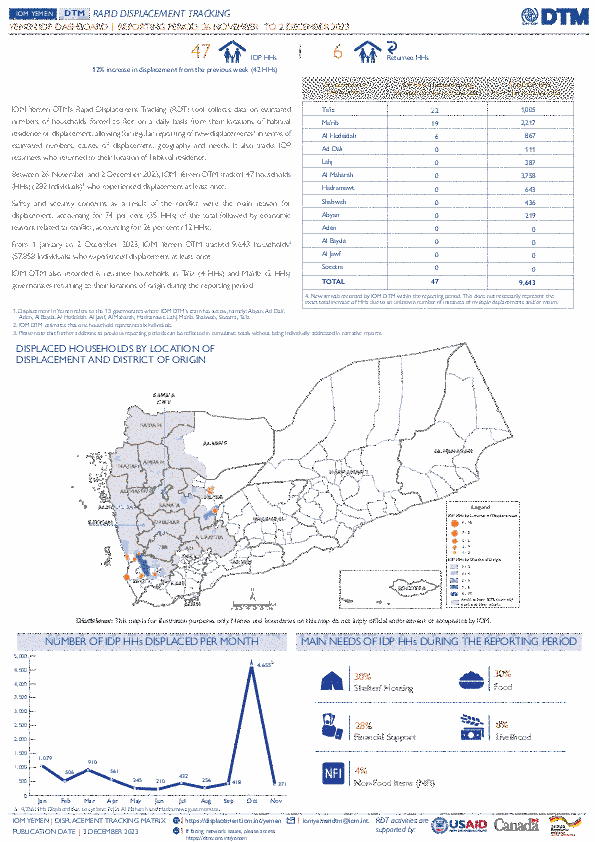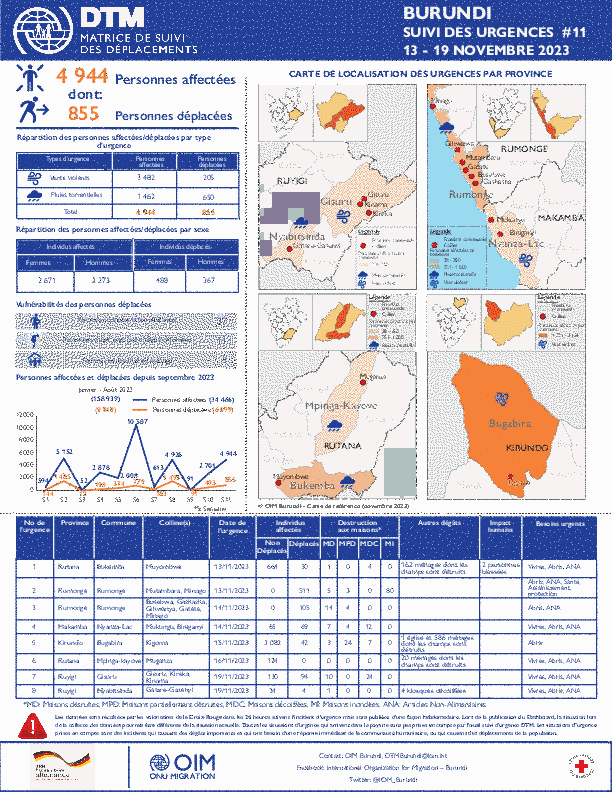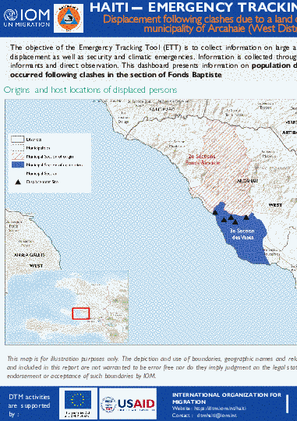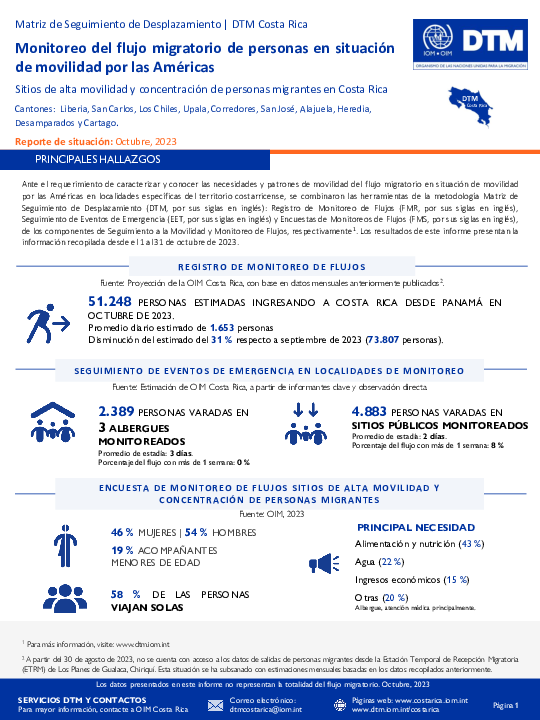-
Countries
-
Data and Analysis
-
Special Focus
-
Crisis Responses
Event Tracking
Contact
DTM Yemen, iomyemendtm@iom.int
Location
Yemen
Activity
- Mobility Tracking
- Event Tracking
Period Covered
Nov 26 2023 -Dec 02 2023
From 1 January to 2 December 2023, IOM Yemen DTM tracked 9,643 households (HH) (57,858 Individuals) who experienced displacement at least once.
Between 26 November and 2 December 2023, IOM Yemen DTM tracked 47 households (282 individuals) displaced at least once. The majority of people moved into/within the following governorates and districts:
Al Hodeidah (14 HHs) – At Tuhayta (3 HHs), Hays (3 HHs), Al Hawak (3 HHs) districts.
Ta’iz (11 HHs) – Maqbanah (8 HHs), Al Maafer (3 HHs) districts.
Ma’rib (5 HHs) – Harib (5 HHs) district.
- Ta’iz (22 HHs) – Al Makha (12 HHs), Mawza (6 HHs), Al Maafer (4 HHs) districts. Most displacements in the governorate originated from Taiz and Al Hodeidah.
- Ma’rib (19 HHs) – Marib (9 HHs), Marib City (5 HHs), Harib (5 HHs) districts. Most displacements in the governorate originated from Taiz and Al Hodeidah.
- Al Hodeidah (6 HHs) – Al Khukhah (5 HHs), Hays (1 HHs) districts. Most displacements in the governorate were internal.
Population Groups
Survey Methodology
Unit of Analysis Or Observation
Type of Survey or Assessment
Keywords
Geographical Scope
Administrative boundaries with available data
The current dataset covers the following administrative boundaries

Contact
DTM Yemen, iomyemendtm@iom.int
Language
English
Location
Yemen
Period Covered
Nov 26 2023
Dec 02 2023
Activity
- Event Tracking
IOM Yemen DTM’s Rapid Displacement Tracking (RDT) tool collects data on estimated numbers of households forced to flee on a daily basis from their locations of origin or displacement, allowing for regular reporting of new displacements in terms of estimated numbers, geography, and needs. It also tracks returnees who returned to their location of origin.
From 1 January to 2 December 2023, IOM Yemen DTM tracked 9,643 households (HH) (57,858 Individuals) who experienced displacement at least once.
Between 26 November and 2 December 2023, IOM Yemen DTM tracked 47 households (282 individuals) displaced at least once. The majority of people moved into/within the following governorates and districts:
- Ta’iz (22 HHs) – Al Makha (12 HHs), Mawza (6 HHs), Al Maafer (4 HHs) districts. Most displacements in the governorate originated from Taiz and Al Hodeidah.
- Ma’rib (19 HHs) – Marib (9 HHs), Marib City (5 HHs), Harib (5 HHs) districts. Most displacements in the governorate originated from Taiz and Al Hodeidah.
- Al Hodeidah (6 HHs) – Al Khukhah (5 HHs), Hays (1 HHs) districts. Most displacements in the governorate were internal.
The majority of people moved from the following governorates and districts:
- Al Hodeidah (14 HHs) – At Tuhayta (3 HHs), Hays (3 HHs), Al Hawak (3 HHs) districts.
- Ta’iz (11 HHs) – Maqbanah (8 HHs), Al Maafer (3 HHs) districts.
- Ma’rib (5 HHs) – Harib (5 HHs) district.

Contact
DTM Somalia, IOMSomaliaDTM@iom.int
Language
English
Location
Somalia
Period Covered
Nov 19 2023
Nov 25 2023
Activity
- Mobility Tracking
- Event Tracking
In response to the Somalia’s severe drought beginning in November 2021, DTM Somalia launched an Emergency Trends Tracking (ETT) tool first in Gedo and Bay regions in 2022, and subsequently in Hiraan, Banadir and Middle Shabelle regions in 2023 to monitor drought related displacement trends and hotspots in support of operational planning. However, during the first half of 2023, conflict and flooding displacements have been significant. Therefore, DTM restructured its ETT tool to capture multi-shock displacements (drought, flood, conflict and other) from October 2023.
ETT is a crisis-based tool that tracks sudden displacement triggered by specific events or emerging crises. The objective of ETT is to help prioritize humanitarian response and to enable partners to deliver rapid assistance.

Contact
DTM Burundi, DTMBurundi@iom.int
Language
English
Location
Burundi
Period Covered
Nov 13 2023
Nov 19 2023
Activity
- Mobility Tracking
- Event Tracking
La DTM a identifié 4 944 personnes affectées (942 ménages) dont 855 personnes déplacées (150 ménages) par les pluies torrentielles et les vents violents dans les provinces de Rutana, Rumonge, Makamba, Kirundo, et Ruyigi.

Contact
dtmhaiti@iom.int
Language
English
Location
Haiti
Period Covered
Nov 29 2023
Nov 29 2023
Activity
- Mobility Tracking
- Event Tracking
Around 15 November 2023, clashes that occurred in the Fonds Baptiste section (Municipality of Arcahaie), following a land conflict, caused the displacement of approximately 2,008 households made up of more than 10,000 people.
Among these people, around 7,000 took refuge with host families and 3,000 in 5 sites (Vice-delegation of Arcahaie, the Saintard community school, the Carrefour Poy center, K Fils Aimé Labarrre and the Thomas).
More detailed information, such as the number of people per site, is being collected in coordination with the Civil Protection of the municipality of Arcahaie.
Contact
DTM Yemen, iomyemendtm@iom.int
Location
Yemen
Activity
- Mobility Tracking
- Event Tracking
Period Covered
Nov 19 2023 -Nov 25 2023
From 1 January to 25 November 2023, IOM Yemen DTM tracked 9,571 households (HH) (57,426 Individuals) who experienced displacement at least once.
Between 19 and 25 November 2023, IOM Yemen DTM tracked 42 households (252 individuals) displaced at least once. The majority of people moved into/within the following governorates and districts:
- Al Hodeidah (26 HHs) – Al Khukhah (13 HHs), and Hays (13 HHs) districts. Most displacements in the governorate were internal.
- Ma’rib (10 HHs), Ma’rib City (7 HHs), and Ma’rib (3 HHs) districts. Most displacements in the governorate originated from Al Hodeidah and Ma’rib.
- Ta’iz (5 HHs) – Al Makha (5 HHs) district. Most displacements in the governorate originated from Al Hodeidah and Hadramawt.
- Al Hodiedah (31 HHs) - At Tuhayta (15 HHs), Al Jarrahi (9 HHs), Ad Durayhimi (3 HHs) districts.
- Ta’iz (5 HHs) – Maqbanah (3 HHs), At Taiziyah (2 HHs) districts.
- Ma’rib (2 HHs) – Madghal Al Jidan (2 HHs) district.
Population Groups
Survey Methodology
Unit of Analysis Or Observation
Type of Survey or Assessment
Keywords
Geographical Scope
Administrative boundaries with available data
The current dataset covers the following administrative boundaries

Contact
DTM Somalia, IOMSomaliaDTM@iom.int
Language
English
Location
Somalia
Period Covered
Nov 12 2023
Nov 18 2023
Activity
- Mobility Tracking
- Event Tracking
In response to the Somalia’s severe drought beginning in November 2021, DTM Somalia launched an Emergency Trends Tracking (ETT) tool first in Gedo and Bay regions in 2022, and subsequently in Hiraan, Banadir and Middle Shabelle regions in 2023 to monitor drought related displacement trends and hotspots in support of operational planning. However, during the first half of 2023, conflict and flooding displacements have been significant. Therefore, DTM restructured its ETT tool to capture multi-shock displacements (drought, flood, conflict and other) from October 2023.
ETT is a crisis-based tool that tracks sudden displacement triggered by specific events or emerging crises. The objective of ETT is to help prioritize humanitarian response and to enable partners to deliver rapid assistance.

Contact
DTMCostaRica@iom.int
Language
English
Location
Costa Rica
Period Covered
Oct 01 2023
Oct 30 2023
Activity
- Flow Monitoring
- Mobility Tracking
- Event Tracking
Cantons: Liberia, Los Chiles, San Carlos, Heredia, Alajuela, Cartago, San José y Corredores.
Costa Rica, like the other countries in the Central American region, has been characterized as a migratory corridor for people who transit by land from the south to the north of America and whose destination is the countries in the north of the continent. This flow on the move through the Americas is mainly made up of people from the Bolivarian Republic of Venezuela, Cuba, Haiti, Ecuador, as well as people from other countries in South America, Africa and Asia.
According to estimations from IOM Costa Rica, during October 51,248 people entered the country, an average of 1,653 people per day and estimating a decrease of 31% compared to September 2023. In addition, 2,389 people stranded in the monitored shelters were identified and 4,883 people stranded in the public places visited.

Contact
DTMCostaRica@iom.int
Language
Spanish
Location
Costa Rica
Period Covered
Oct 01 2023
Oct 30 2023
Activity
- Flow Monitoring
- Mobility Tracking
- Event Tracking
Cantones: Liberia, Los Chiles, San Carlos, Heredia, Alajuela, Cartago, San José y Corredores.
Costa Rica, al igual que los demás países de la región centroamericana, se ha caracterizado por ser un corredor migratorio para personas que transitan de manera terrestre desde el sur hasta el norte de América y que tienen como destino los países del norte del continente. Este flujo en situación de movilidad por las Américas se encuentra compuesto principalmente por personas de la República Bolivariana de Venezuela, Cuba, Haití, Ecuador, así como personas provenientes de otros países de Suramérica, África y Asia.
Según estimaciones de la OIM Costa Rica, durante octubre ingresaron al país 51.248 personas, un promedio de 1.653 personas por día y estimando una disminución de un 31% con respecto a setiembre de 2023. Además, se identificaron 2.389 personas varadas en los albergues monitoreados y 4.883 personas varadas en los sitios públicos visitados.

Contact
DTM DRC, iomdrcdtm@iom.int
Language
French
Location
Democratic Republic of the Congo
Period Covered
Oct 27 2023
Nov 19 2023
Activity
- Event Tracking
Depuis le début de la crise, l'OIM, par le biais de la DTM continue à mener une série d'évaluations rapides, y compris le suivi des urgences (EET/ERM), l'analyse des crises et enregistrement avec priorité de répondre aux besoins immédiats d'information en vue de comprendre la dynamique des déplacements et les besoins. Ce rapport présente les résultats des évaluations menées dans les différentes zones de déplacement et de retour du 27 octobre au 19 novembre 2023.
Les données sur les déplacements recueillies dans le cadre de cette dixième analyse de crise montrent une nouvelle augmentation du nombre de personnes déplacées par rapport à la publication précédente. Le nombre de déplacés internes est passé de 908 920 à 1 076 261 personnes au 19 novembre 2023, soit une augmentation de 167 341 individus ou 18 pour cent. Cette augmentation est due aux multiples attaques, notamment celle qui a touché les territoires de Rutshuru, Masisi et Nyiragongo
Pagination
- Previous page
- Page 55
- Next page
